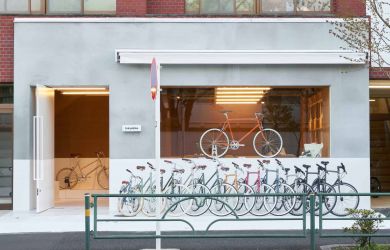
November 5, 2009
Ladies First
A pair of former OL’s roll up their sleeves to create a thriving real estate niche
By Metropolis
[imageflow id=”2″]
TKGF operates fun and funky residences in Harajuku, Asakusa, Yoyogi-Koen, Nishi-Azabu and Minami-Aoyama.
When TKGF finds a willing landlord—or, as is most often the case these days, when a desperate landlord finds them—Tahara and Arai literally roll up their sleeves and get to work. For larger units, like their properties in Nishi-Azabu and Roppongi, they section off big living rooms into a separate bedroom and lounge area. Western-style master bedrooms are divided into a pair of spaces that Japanese renters feel comfortable sleeping in.
The first step, however, is to devise an appealing interior scheme. Arai and Tahara conceive of and implement designs based around keywords like “Mid-Century Modern” and “Princess Room.” Most of the units’ common areas sport bright colors and offbeat graphical elements—the “House of Koi” in Aoyama, for instance, features a fish-themed, nihonga-esque wall painting. (Koi can refer to both “carp” and “romance.”) Elegant furnishings like claw-foot bathtubs and antique sofas complete the scene.
“We used to shop at Ikea, but not anymore,” says Arai. “They’re too obvious in their design, and we didn’t want out residents to put up with that.”
“Normal women love our designs, but when a professional checks out our work, we get a lot of negative comments,” she continues. “Like, ‘Why match a leopard pattern floor with a red wall?’ It’s not like we ever studied design at school, and our concepts tend to be open and free. Many of our residents say it puts them at ease.”
With their camera-ready good looks and handiness with power tools, Arai and Tahara have become darlings of the local media. But they owe much of their success to a savvy business insight: female Tokyoites are now ready to accept shared accommodations. This concept is more innovative than it might seem. While Westerners have long been comfortable with communal living arrangements—hostels, guesthouses, dorm rooms and apartments—the notion is still novel in Japan, where the separation between private and public spaces tends to be more distinct.
As is the case with so many aspects of life here, though, these traditional attitudes are beginning to change. One big factor is a growing sense of insecurity—both economic and physical—that afflicts younger Japanese, especially women.
“The fact that there’s always someone there when I come home was one of the things that attracted me to this kind of living arrangement,” says “Yuri,” 29, a TKGF resident who works at a publishing company in Tokyo. “I get to live in a clean place in an area that I wouldn’t be able to afford otherwise.”
TKGF’s rivals also emphasize peace of mind. “The residents don’t have to worry about the eyes of men, so they can really relax,” says one landlord at a competing company, who asked that neither he nor his firm be named. “These apartments concentrate on improving the quality of life for women, so there are a lot of benefits compared to residences that allow men.”
Some commentators go even further. Tomoyuki Utsumi, a Tokyo-based architect and an expert on the dynamics of Japanese living spaces, suggests that the newfound popularity of communal habitation represents a deeper cultural shift and a more enlightened approach toward interpersonal relationships.
“Sharing space means that individuals must sense each other’s values and intuitively understand the distance that exists between them—both physically and psychologically,” he says. “This is a new form of social intelligence, and I’d say that women are instinctively much more capable at it than men”.
“Kei,” a Tokyo-based consultant who moved to a TKGF residence from her hometown of Omiya, overcame her initial reluctance about communal living and is now enjoying the benefits of an extended community.
“I was worried at first about sharing a place with strangers,” she says, “but once I actually started living there, it was surprisingly comfortable and I didn’t care at all about the other residents.”
As is the case with any new lifestyle trend, the rise of shared accommodations has brought its share of difficulties. Arai and Tahara say that they visit three or four of residences a day, not only in their official roles as mediators between tenants and landlords, but as peace brokers in disputes among roommates.
“There hasn’t been any big trouble, but we still see a lot of small issues,” says Tahara, repeating a refrain that will be familiar to anyone who’s ever had a roomie. “You can compare sharing rooms with strangers to getting married. Mundane things can lead to arguments, like leaving the toilet lid open or not, or those who clean up after themselves and those who don’t.” The most common complaint? “Hair stuck in the shower drain.”
Yet the zeal with which women have taken to the TKGF concept seems to validate the view of Utsumi, the architect, that shared accommodations can inspire new ways of thinking. By accepting “outsiders” into their space, roommates participate in an exchange that opens them up to the possibility of personal enrichment.
Of course, this being Japan, that enrichment often has a material aspect.
“Living with other girls and learning things like how they do their makeup and wear their clothes stimulates my sense of style,” Yuri says.
Nor is it lost on many residents that Arai and Tahara are the very model of successful and stylish career women that they themselves wish to become.
“I was impressed by the concept and their interior design, and the fact that the two women managing all of this are around my age,” says Yuri. “I’m interested in starting a business of my own in the future, so I’m keen on learning how they came this far.”
For more information about Tokyo Girls Fudosan, see http://tkgf.jp (Japanese) or call 03-5772-6385 (Japanese and English).







